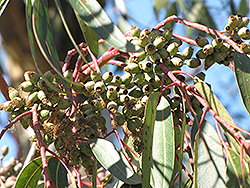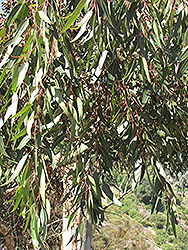It's all about ...
plants

Narrow-Leaved Peppermint
Eucalyptus radiata
Height: 90 feet
Spread: 50 feet
Sunlight:
![]()
Hardiness Zone: 8b
Other Names: Forth River Peppermint, Willow Peppermint
Description:
A straight erect tree that grows quite tall, but can be regularily pruned to size; fine willow-like foliage; a beautiful landscape specimen, alone or in groups, with a fine airy texture
Ornamental Features
Narrow-Leaved Peppermint is primarily valued in the landscape for its ornamental upright and spreading habit of growth. It features subtle white button flowers at the ends of the branches in mid summer. It has attractive bluish-green foliage with grayish green undersides. The fragrant narrow leaves are highly ornamental and remain bluish-green throughout the winter. The peeling gray bark and brick red branches are extremely showy and add significant winter interest.
Landscape Attributes
Narrow-Leaved Peppermint is an evergreen tree with an upright spreading habit of growth. It lends an extremely fine and delicate texture to the landscape composition which can make it a great accent feature on this basis alone.
This tree will require occasional maintenance and upkeep, and can be pruned at anytime. It has no significant negative characteristics.
Narrow-Leaved Peppermint is recommended for the following landscape applications;
- Accent
- Shade
- Vertical Accent
Planting & Growing
Narrow-Leaved Peppermint will grow to be about 90 feet tall at maturity, with a spread of 50 feet. It has a high canopy of foliage that sits well above the ground, and should not be planted underneath power lines. As it matures, the lower branches of this tree can be strategically removed to create a high enough canopy to support unobstructed human traffic underneath. It grows at a fast rate, and under ideal conditions can be expected to live for 60 years or more.
This tree should only be grown in full sunlight. It does best in average to evenly moist conditions, but will not tolerate standing water. It is particular about its soil conditions, with a strong preference for sandy, acidic soils, and is able to handle environmental salt. It is somewhat tolerant of urban pollution. This species is not originally from North America.
This plant is not reliably hardy in our region, and certain restrictions may apply; contact the store for more information.


